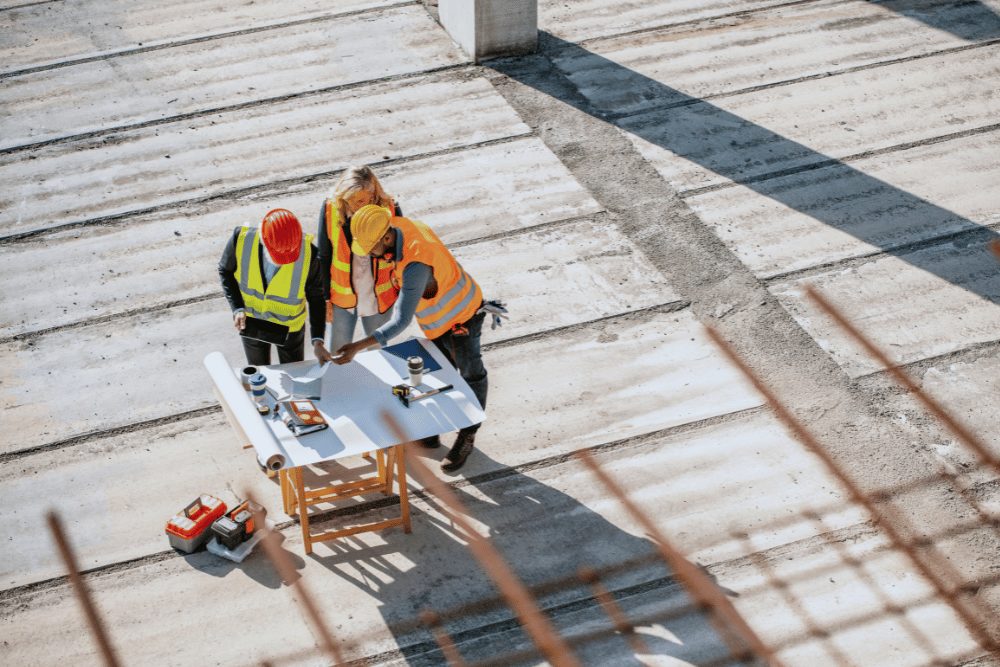How to Set Up a Construction Site Security Plan

Construction site security is more important than you might think. Losses and damage are frequent, costly, and (most importantly) preventable. Bare minimum security is not enough. Below, you’ll learn the critical steps in setting up an effective construction site security plan so you can protect your job site.
Why You Need a Construction Site Security Plan
But first, do you need some motivation? Here are a few examples of crimes that could have been stopped with better planning.
On New Year’s Eve in 2022, two thieves broke into a Philadelphia area construction site and stole $60,000 worth of equipment. Security cameras were recording when the thieves first arrived, yet no one was monitoring the feeds. As a result, thieves were able to disconnect the cameras and take what they wanted. No one was the wiser.
More examples include:
- Thieves driving an excavator off a construction site in rural Belmont, New Hampshire site.
- In rural Carlisle, Pennsylvania, thieves made off with a trailer.
Construction site theft, arson, and vandalism occur all over, in both urban and rural areas. Your site isn’t immune, so it’s time to create a construction site security plan.
Job Sites Are at Risk
According to the National Equipment Register (NER), thefts occur at one of every five construction sites. Collectively, these crimes add up to $1 billion in stolen goods each year. The organization pegs the average cost of a single instance of equipment theft at $30,000.
What drives these crimes? For one, the payoff.
Thieves can earn top dollar for construction materials like copper wiring, tools, lumber, and aluminum. Also, construction sites are relatively easy to access. They’re often in remote areas with few people around to pay attention, especially at night. On top of that, there are few obstacles to stop thieves from gaining access. A pair of wire cutters is often all intruders need to get inside.
However, theft is just one of several security issues you’ll want to take safeguards to prevent. Others include:
- Vandalism, like the retaining wall that vandals ripped apart during the middle of the night on a New Jersey construction site.
- Arson, which is among the top reasons construction sites go up in flames, according to Traveler’s Insurance.
- Employee misconduct, like the contractors who terrorized workers with hate symbols at a warehouse construction site.
A detailed job site security plan can help you to prevent these problems.
6 Steps to Create an Effective Construction Site Security Plan
Step 1: Assess Your Risks
Your security risks depend on several factors.
- Your construction type: Horizontal construction, such as roads and pipelines, can span miles. That makes protecting them more challenging. On the other hand, vertical construction, like office buildings, takes up much less space. They’re easier to protect with fencing, walls, and cameras.
- Your site location: If your site is in a highly populated area, it will be more difficult for thieves to break in unnoticed.
- Public sentiment: If your project is seen as a community benefit, vandalism and arson risks decrease. If it’s seen as a nuisance or inconvenience, your risk goes up.
- The surrounding crime rate: Building in a high-crime area is naturally riskier. You probably don’t have control over this factor, but you still must acknowledge it.
- Employee satisfaction: Don’t forget that crime can come from within. In fact, paying workers on time is one way to drive down theft, as unhappy workers could steal materials to make up for lost pay.
During the risk assessment phase of your planning, it’s a good idea to meet with local, county, or state law enforcement. Ask them for help in understanding the area’s crime statistics.
Make sure you know the answers to these questions:
- What is the value of your equipment and materials?
- What equipment and materials are in high demand on the black market?
- What is the crime rate in the area?
- What types of crimes are common there?
- How has crime affected neighboring properties?
- What security measures do you already have in place?
- What security measures are missing? (See steps 3-6 for ideas.)
Step 2: Match Your Risks to Tactics
Now that you know what you’re up against, it’s time to mitigate the risks. For each potential issue that you identified, brainstorm 2-3 security measures you can take to minimize or eliminate the problem. One risk could require several security tactics, and one security tactic could mitigate multiple risk areas. It’s all theoretical at this point, so dream big.
Once you have this list, narrow the options based on what is practical within the scope of your resources and site parameters. Price out any new purchases. You might be able to eliminate some tactics that overlap significantly.
This list is the basis for your construction site security plan. Now it’s time to put that plan into action.
Step 3: Make Your Site Difficult to Access
You may not be able to stop every single intruder from gaining access to your site. That said, by protecting your perimeter, you can greatly slow them down and give law enforcement more time to respond.
Explore surrounding your site with anti-climb barriers. If local regulations allow, barbed wires and electrification offer added protection. Consider using privacy fencing for vulnerable areas. This fencing can shield these areas from view, making it more difficult for criminals to case your site.
When erecting fencing, use these pointers:
- Use lighting to illuminate the boundary created by the fence.
- Post no-entry signs at regular intervals.
- Add concrete barriers in front of gates and other vulnerable areas to prevent criminals from using a vehicle to ram through your fencing.
- Include a clear zone along the fencing to serve as a firebreak.
- Walk the perimeter regularly to check for breaches.
- Frequently change the gate locks.
If anyone can walk through the gate, your fence won’t do much good. At your gate, use biometrics, face recognition software, or ID badges for workers to clock in and out.
Step 4: Make Equipment Harder to Steal
Create a plan for locking and storing tools, materials, and big equipment. As a part of this plan, you’ll want to:
- Make a list of your assets and their registration, serial, and plate numbers.
- Snap photos of expensive machinery.
- Consider welding your company name onto your equipment.
- Disable heavy equipment at the end of the workday. Use hidden ignition, disable switches, or remove their batteries.
- Install GPS tracking systems and anti-theft devices.
- Park equipment in well-lit areas. Surround easier-to-steal small equipment with larger, harder-to-move equipment.
- If possible, store high-value materials offsite, where thieves won’t know to look.
Step 5: Set Up Alarms
A blaring alarm can draw the attention of passers-by and deter intruders. But ideally, you want alarms that do more than simply make loud noises.
For example, if you combine alarms with video surveillance (see step 6), a remote guard can warn thieves that the police are on the way. This is often more effective than only blaring a loud noise. The verbal warning ensures thieves know that someone is watching, and that time is limited.
Step 6: Install the Right Construction Security Cameras
Older security cameras recorded passively. That footage is only helpful in catching criminals after the fact.
However, new analytic tools like artificial intelligence (AI) have transformed the camera surveillance industry. This software can distinguish between an animal and a criminal, significantly reducing false alarms. Smart surveillance cameras can massively reduce your security costs (and even your insurance premiums).
You’d need a robust team of security guards to patrol the typical sprawling construction site. That can add up to thousands of dollars per month. By comparison, a smart surveillance system costs much less and provides better coverage.
At Deep Sentinel, live guards work hand-in-hand with AI-enhanced job site security cameras. When the system’s AI senses unusual activity, it alerts a human guard to check the feed. If someone’s up to no good, live guards issue a verbal warning and alert the police. All of this takes place in mere seconds.
The right security cameras at your job site eliminate the need for older, less effective methods. It’s a win-win.
What to Do After Implementing a Construction Site Security Plan
Security planning isn’t a one-and-done process. After you’ve implemented your plan, you need to evaluate and tweak it regularly. After any breaches, do an audit to discover what went wrong and how you could have prevented it.
Plan, implement, test, update. Keep that cycle going, and your job site will be safe from the day you break ground to the day you cut the ribbon.
Need a Solution that Prevents Crime?
Deep Sentinel is the only security technology that delivers the experience of a personal guard on every customer’s home and business. Visit deepsentinel.com/business or call 833-983-6006

